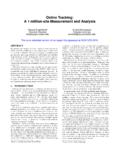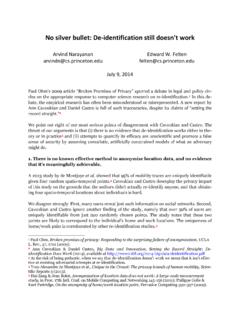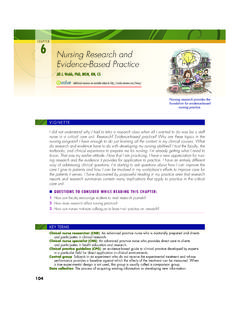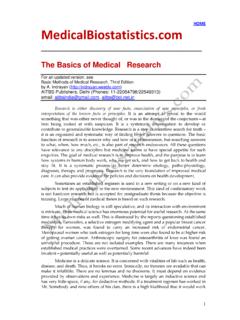Transcription of A Critical Look at Decentralized Personal Data …
1 A Critical Look at Decentralized Personal data Architectures Arvind Narayanan Solon Barocas Vincent Toubiana Helen Nissenbaum Dan Boneh February 20, 2012. ABSTRACT Within five years, nearly all of this excitement had faded and While the Internet was conceived as a Decentralized net- all commercial (Persona, Privada, Lumeria, etc.) and com- work, the most widely used web applications today tend munity (P3P) initiatives had floundered [1] some in truly toward centralization. Control increasingly rests with cen- spectacular fashion, such as AllAdvantage. And yet, by the tralized service providers who, as a consequence, have also end of the decade, many new initiatives and projects that amassed unprecedented amounts of data about the behav- shared almost identical goals emerged. Vendor Relation- iors and personalities of individuals. ship Management (VRM) [35] has gained steady momen- tum as a general set of principles that aim simultaneously Developers, regulators, and consumer advocates have looked to improve user privacy, enhance customer autonomy, and to alternative Decentralized architectures as the natural re- increase market efficiency through a combination of mecha- sponse to threats posed by these centralized services.
2 The nisms that aggregate data in a single (per-user) repository result has been a great variety of solutions that include per- under users' control and tools to negotiate agreements that sonal data stores (PDS), infomediaries, Vendor Relationship would grant outside organizations access to and use of that Management (VRM) systems, and federated and distributed data . social networks. And yet, for all these efforts, Decentralized Personal data architectures have seen little adoption. Parallel efforts to develop so-called Personal data stores (PDS), Personal data servers, Personal data lockers/vaults, and per- This position paper attempts to account for these failures, sonal clouds [18] have focused more narrowly on the plat- challenging the accepted wisdom in the web community on forms and protocols to support unified repositories of user the feasibility and desirability of these approaches. We start data that could be managed locally by the user or outsourced with a historical discussion of the development of various to a trusted third party.
3 The impetus for these projects are categories of Decentralized Personal data architectures. Then varied, ranging from user interest in aggregating one's own we survey the main ideas to illustrate the common themes data in a single location to better derive benefits from their among these efforts. We tease apart the design character- mixing and matching to more explicit interests in privacy istics of these systems from the social values that they (are (user control) and commerce (a market place for sharing, in- intended to) promote. We use this understanding to point cluding possibilities for cash payments in exchange for data ). out numerous drawbacks of the decentralization paradigm, [13]. some inherent and others incidental. We end with recom- mendations for designers of these systems for working to- The similarities between these and earlier efforts can be wards goals that are achievable, but perhaps more limited quite stark: Mydex's recent white paper, The Case for Per- in scope and ambition.
4 Sonal Information Empowerment [38], recapitulates much that was described in a white paper released a full decade earlier by Lumeria, a failed infomediary [30]. To describe 1. BRIEF HISTORICAL OVERVIEW this as a simple case of an idea whose time has come . The search for alternatives to centralized aggregation of per- would be to miss the important lessons that these earlier sonal data began in the late 1990s which saw a wave of and recurring failures should offer those who wish to pursue so-called negotiated privacy techniques' including commer- Decentralized Personal data architectures. cial infomediaries' [24, 16]. These entities would store con- sumers' data and help facilitate the drafting of contracts Decentralized social networking has been a largely parallel, that set the terms of the exchange and use of data . The sometimes overlapping line of development with similar mo- 1999 book Net Worth [23] galvanized both industry and pri- tivations.
5 We subdivide such social networks into federated vacy advocates, generating hopes for a future in which pri- (ecosystem of interoperable implementations in the client- vacy problems could be solved through a mix of decentral- server model) and distributed (peer-to-peer). The term dis- ized storage and private contracts, potentially obviating the tributed social networking is frequently but incorrectly used need for privacy law or even the adoption of fair information to describe all Decentralized social networks. practices [10, 60]. While some early thinking in the semantic web community change. Goldman [21] envisions that software agents will could be classified in this category,1 for the most part decen- make marketing messages perfectly relevant, eliminating ex- tralized social networking appears not to have anticipated ternalities from wasted attention. By Coase's theorem [34], the success of mainstream commercial, centralized social this will lead to a socially optimal level of marketing.
6 Networks, but rather developed as a response to it. Indeed, prominent members of the web community dismissed social Turning to social networks, the key challenge of distributed networks until 2007 2008 (for example, [27] and [15]) and social networks is hosting and message transfer. One solu- academic computer scientists appear to have considered it a tion is to encrypt messages and store them in a distributed passing fad as well in our survey we see a sharp spike in hash table [8, 2]. Another is social replication : messages interest among researchers around this time frame. are stored in plaintext in a redundant manner by those who have access rights (typically friends of the message poster). A series of well-publicized privacy mishaps by Facebook and [49]. Message passing sometimes exploits the relationship Google starting in 2009 that reached its crescendo around between the social graph and the topology of the physical the 2010 f8 developer conference stirred up interest among network [25, 8].
7 The public and Perhaps the most well known project that resulted is Diaspora3 , which was funded in Another frequent goal is keeping edges of the graph secret, excess of $200,000 via the crowd funding platform kick- for which various solutions have been proposed: a crypto- As of this writing Wikipedia lists about 40 graphic approach [5], anonymous routing [14] and friend- Decentralized social networks [58], most of which are feder- to-friend networks such as Freenet in darknet' mode [12]. ated, whereas the academic literature has focused on dis- Persona takes the cryptographic heavy-lifting a step further tributed social networking for natural reasons, since those to enable fine-grained access control using attribute-based present more research challenges. encryption [6]. 2. REPRESENTATIVE SURVEY Other models for hosting have been explored. In vis-a-vis, Rather than attempt an exhaustive survey, in this section each user owns an EC2 virtual host that is active at all we list the key ideas that have been explored in the course times [48], whereas FreedomBox4 proposes cheap plug com- of developing Decentralized designs.
8 There has been a great puters. Lam et al. have proposed email as a backend [19]. fecundity of creative and complex ideas in this space span- and ephemeral networks on smartphones [17]. Unhosted5. ning the realms of technology, law and economics; we are proposes separating data from code, but keeping both in unable to present them in detail due to space constraints. the cloud. Along similar lines, Frenzy6 is a distributed so- We refer the reader to the cited works. cial network software with Dropbox as the backend. Polaris proposes reducing existing social networks such as Youtube The core idea of an infomediary is that of a trusted third and Twitter to datastores and layering a social network on party that interfaces between the user and commercial enti- top, with smartphones providing access control management ties such as marketers [23]. Users' Personal data can be man- interfaces [59]. ually given to the infomediary, as in Lumeria, or collected through passive monitoring, as in AllAdvantage and other Finally, federated social networks aim to create an ecosys- systems [20].
9 That information can then be utilized without tem of standards-based interoperable implementations of so- explicit monetization (Mydex, etc.), or users can be paid for cial networks. Some designs such as Diaspora are a hybrid their data (AllAdvantage, Bynamite [29], etc). It has var- between distributed and federated. OStatus, being coordi- iously been argued that telecommunications providers [55, nated by the W3C, represents an interesting approach to 4], banks [9] and other parties such as providers of home standardization for federated microblogging: it references a entertainment set-top boxes are ideally suited to play the suite of existing protocols rather than developing them from role of the intermediary. An infomediary might also enable scratch. a targeted attention market [39] based on user preferences. 3. CLASSIFICATION. Kang et al. introduce the intriguing idea of licensing inter- mediaries to increase their trustworthiness [28].
10 In the other Table 1: The four types of architectures that are the direction, Vendor Relationship Management systems largely subject of our study eliminate the infomediary as a separate entity, and instead Commerce, Health etc. Social Networking replace it with a software agent [35]. Some software interme- Self-hosted PDS / VRM Distributed diaries like Adnostic use cryptography to achieve additional Outsourced Infomediary Federated privacy properties [54]. Other ideas for improving privacy include fine-grained access control lists [37]. We emphasize that the division in Table 1 is only meant to provide the reader with a rough mental map and is far from Both VRM and infomediary systems often emphasize ben- precise. The vertical axis, in particular, is closer to a spec- efits to the firm from the intermediated nature of the ex- trum than a strict division. The terms Personal data Store 1. The Internet Archive lists a version of the Friend of a and Vendor Relationship Management do not appear to have Friend (FOAF) project ( ) from August a single definition.






